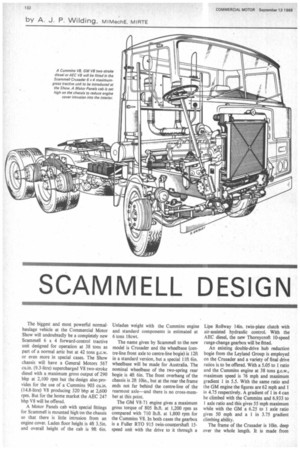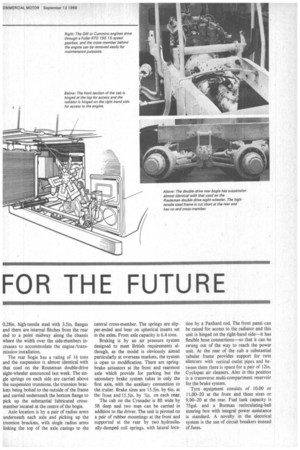SCAMMELL DESIGN FOR THE FUTURE
Page 134

Page 135

If you've noticed an error in this article please click here to report it so we can fix it.
The biggest and most powerful normalhaulage vehicle at the Commercial Motor Show will undoubtedly be a completely new Scammell 6 x 4 forward-control tractive unit designed for operation at 38 tons as part of a normal artic but at 42 tons g.c.w. or even more in special cases. The Show chassis will have a General Motors 567 cu.in. (9.3-litre) supercharged V8 two-stroke diesel with a maximum gross output of 290 bhp at 2,100 rpm but the design also provides for the use of a Cummins 903 cu.in. (14.8-litre) V8 producing 320 bhp at 2,600 rpm. But for the home market the AEC 247 bhp V8 will be offered.
A Motor Panels cab with special fittings for Scammell is mounted high bn the chassis so that there is little intrusion from an engine cover. Laden floor height is 4ft 3.51n. and overall height of the cab is 9ft 6in. Unladen weight with the Cummins engine and standard components is estimated at 6 tons 18cwt.
The name given by Scammell to the new model is Crusader and the wheelbase (centre-line front axle to centre-line bogie) is 12ft in a standard version, but a special lift 6in. wheelbase will be made for Australia. The nominal wheelbase of the two-spring rear bogie is 411 6in. The front overhang of the chassis is 211 10in., but at the rear the frame ends not far behind the centre-line of the rearmost axle—and there is no cross-member at this point.
The GM V8-71 engine gives a maximum gross torque of 805 lb.ft. at 1,200 rpm as compared with 710 lb.ft. at 1,800 rpm for the Cummins V8. In both cases the gearbox is a Fuller RTO 915 twin-countershaft 15speed unit with the drive to it through a Lipe Railway 14in. twin-plate clutch with air-assisted hydraulic control. With the AEC diesel, the new Thornycroft 10-speed range-change gearbox will be fitted.
An existing double-drive hub reduction bogie from the Leyland Group is employed on the Crusader and a variety of final drive ratios is to be offered. With a 5.05 to 1 ratio and the Cummins engine at 38 tons g.c.w., maximum speed is 76 mph and maximum gradient 1 in 5.5. With the same ratio and the GM engine the figures are 62 mph and 1 in 4.75 respectively. A gradient of 1 in 4 can be climbed with the Cummins and 6.933 to I axle ratio and this gives 55 mph maximum while with the GM a 6.25 to 1 axle ratio gives 50 mph and a 1 in 3.75 gradient climbing ability.
The frame of the Crusader is 10in, deep over the whole length. It is made from 0.28in, high-tensile steel with 3.5in. flanges and there are internal flitches from the rear end to a point midway along the chassis where the width over the side-members increases to accommodate the engine/transmission installation.
The rear bogie has a rating of 16 tons and the suspension is almost identical with that used on the Routeman double-drive eight-wheeler announced last week. The single springs on each side are carried above the suspension trunnions. the trunnion brackets being bolted to the outside of the frame and carried underneath the bottom flange to pick up the substantial fabricated crossmember located at the centre of the bogie.
Axle location is by a pair of radius arms underneath each axle and picking up the trunnion brackets, with single radius arms linking the top of the axle casings to the central cross-member. The springs are slipper-ended and bear on spherical inserts set in the axles. Front axle capacity is 6.4 tons.
Braking is by an air pressure system designed to meet British requirements although, as the model is obviously aimed particularly at overseas markets, the system is open to modification. There are springbrake actuators at the front and rearmost axle which provide for parking but the secondary brake system takes in only the first axle, with the auxiliary connection to the trailer. Brake sizes are 15.5in. by 6in. at the front and 15.5in. by 7in. on each rear.
The cab on the Crusader is 8ft wide by 5ft deep and two men can be carried in addition to the driver. The unit is pivoted on a pair of rubber mountings at the front and supported at the rear by two hydraulically damped coil springs, with lateral loca
tion by a Panhard rod. The front panel can be raised for access to the radiator and this unit is hinged on the right-hand side—it has flexible hose connections—so that it can be swung out of the way to reach the power unit. At the rear of the cab a substantial tubular frame provides support for twin silencers with vertical outlet pipes and between them there is space for a pair of I 2in. Cyclopac air cleaners. Also in this position is a transverse multi-compartment reservoir for the brake system.
Tyre equipment consists of 10.00 or 11.00-20 at the front and these sizes or 9.00-20 at the rear. Fuel tank capacity is 75gal. and a Burman recirculating-ball steering box with integral power assistance is standard. A novelty in the electrical system is the use of circuit breakers instead of fuses.




































































































































































































































































